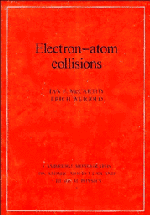Book contents
- Frontmatter
- Contents
- Preface
- 1 Introduction
- 2 Experimental techniques for cross-section measurements
- 3 Background quantum mechanics in the atomic context
- 4 One-electron problems
- 5 Theory of atomic bound states
- 6 Formal scattering theory
- 7 Calculation of scattering amplitudes
- 8 Spin-independent scattering observables
- 9 Spin-dependent scattering observables
- 10 Ionisation
- 11 Electron momentum spectroscopy
- References
- Index
1 - Introduction
Published online by Cambridge University Press: 15 December 2009
- Frontmatter
- Contents
- Preface
- 1 Introduction
- 2 Experimental techniques for cross-section measurements
- 3 Background quantum mechanics in the atomic context
- 4 One-electron problems
- 5 Theory of atomic bound states
- 6 Formal scattering theory
- 7 Calculation of scattering amplitudes
- 8 Spin-independent scattering observables
- 9 Spin-dependent scattering observables
- 10 Ionisation
- 11 Electron momentum spectroscopy
- References
- Index
Summary
The detailed study of the motion of electrons in the field of a nucleus has been made possible by quite recent developments in experimental and calculational techniques. Historically it is one of the newest of sciences. Yet conceptually and logically it is very close to the earliest beginnings of physics. Its fascination lies in the fact that it is possible to probe deeper into the dynamics of this system than of any other because there are no serious difficulties in the observation of sufficiently-resolved quantum states or in the understanding of the elementary two-body interaction.
The utility of the study is twofold. First the understanding of the collisions of electrons with single-nucleus electronic systems is essential to the understanding of many astrophysical and terrestrial systems, among the latter being the upper atmosphere, lasers and plasmas. Perhaps more important is its use for developing and sharpening experimental and calculational techniques which do not require much further development for the study of the electronic properties of multinucleus systems in the fields of molecular chemistry and biology and of condensed-matter physics.
For many years after Galileo's discovery of the basic kinematic law of conservation of momentum, and his understanding of the interconversion of kinetic and potential energy in some simple terrestrial systems, there was only one system in which the dynamical details were understood. This was the gravitational two-body system, whose understanding depended on Newton's discovery of the 1/r law governing the potential energy. By understanding the dynamics we mean keeping track of all the relevant energy and momentum changes in the system and being able to predict them accurately.
- Type
- Chapter
- Information
- Electron-Atom Collisions , pp. 1 - 3Publisher: Cambridge University PressPrint publication year: 1995
- 3
- Cited by

